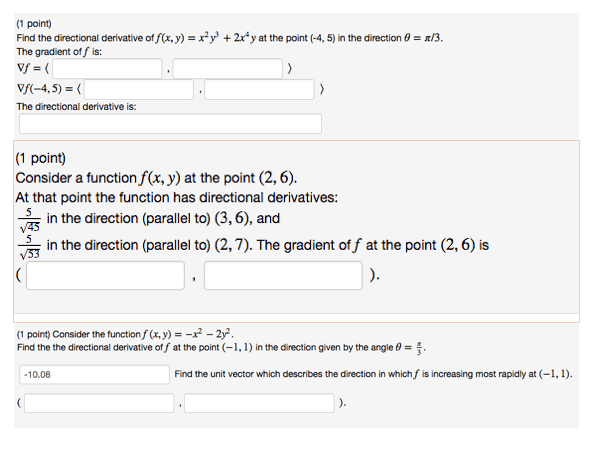MATH 200 Lecture Notes - Lecture 1: Tangent Space, Directional Derivative, Unit Vector
Review of normal vectors and directional derivatives
1 Formulas and conceptual concepts
Definitions (explain in words)
•What is the normal vector to a surface at a point?
•What is a directional derivative at a point?
•What is a tangent plane?
Formulas
•Gradient
•Differential
•Tangent plane
•Normal vector to a surface at a point
•Directional derivative
•Direction of a vector tangent to a surface
•Can you generalize all of the above for a three variable function w=f(x, y, z)?
Conceptual ideas (For some pictures see the following link)
•What is the meaning of the direction of the gradient?
•What is the meaning of the magnitude of the gradient?
•For a surface z=f(x, y) in R3the gradient vector only has two coordinates. How can you
visualize this gradient vector in R3? How does this gradient vector compare to the level curve?
•Explain why for a surface c=F(x, y, z) (cis a constant), like 9 = x2+y2+z2, the gradient
OFis the normal vector.
•Find one reason why your formula for a normal vector at a point is indeed normal to the
surface.
•Explain why the directional derivative formula is true. (Hint: differentials)
•Given a direction ~v (which may or may not be a unit vector) how does the formula for the
directional derivative change?
•Explain why directional vector for the tangent line at a point makes sense. How does it relate
to the directional derivative?
•Given a direction ~v (which may or may not be a unit vector) how does the formula for the
directional vector for the tangent line at a point change?
1

51
MATH 200 Full Course Notes
Verified Note
51 documents
Document Summary
How does this gradient vector compare to the level curve: explain why for a surface c = f (x, y, z) (c is a constant), like 9 = x2 + y2 + z2, the gradient. The secondary text # 1 has solutions for nearly all problems. practice you can try all the problems in the section. For problems with guided solutions look at the mentioned examples from the main text. Find the directional derivative of f , at p , in the following directions: towards q = (3, 4). Towards the origin: example 423 from main text: let f (x, y) = sin x cos y and let p = ( /3, /3). Harder problems / applications: secondary text # 1 section 14. 5 # 8, 16, 18 (page 370 of text, example 425 from main text: consider the surface given by f (x, y) = 20 x2 2y2 . Water is poured on the surface at (1, 1/4).


